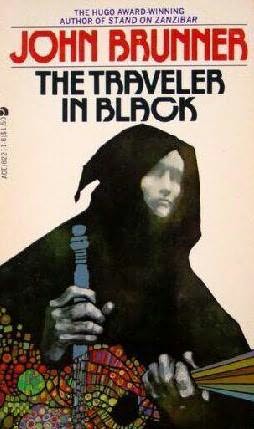John Brunner’s The Traveller in Black isn’t much like anything else at all. It’s a fantasy book by a science fiction writer, and it’s deeply weird. When I first read it, I was completely blown away by it. I now recognise that it has influences—most particularly Lord Dunsany, who was so much in eclipse when I was coming into reading SF and fantasy that though I heard him mentioned here and there, I didn’t discover him for a long time. (When I did, then felt I like some watcher of the skies when some new planet sweeps into his ken, or like stout Cortez, when with eagle eyes he stared at the Pacific, and all his men looked at each other in a wild surmise, silent, upon a peak, in Darien.) Anyway, The Traveller in Black is Dunsany-style fantasy, rather than the Tolkien-style fantasy I called “realist magicism.” I read it because Brunner was already one of my favourite writers, I’d probably read a couple of dozen of his works before I picked up this one and read, to my surprise and delight:
He has many names, but one nature, and this unique nature made him subject to certain laws not binding on ordinary persons. In a compensatory fashion, he was also free from certain other laws more commonly in force.
Still, there was nothing to choose from as regards rigidity between his particular set of laws and those others. And one rule by which he had very strictly to abide was that at set seasons he should overlook that portion of the All which had been allotted to him as his individual responsibility.
That’s it, really. He wanders around surveying the All, on the side of order as against Chaos, granting people their wishes (though seldom as they’d like them granted) and seeing things pass from Eternity into Time, until everything has only one nature. The book is a picareaque sequence of wandering about a circuit of peculiar places, mostly grotesque cities, written poetically and with a strange edge to it.
I don’t think it’s as good as I thought it was when I was fourteen, or even as good as I thought it was when I bought the attractive Methuen edition (with an extra chapter, well worth having ) which I now own, in 1985. But I keep coming back to it at certain times, usually in the middle of the night when I can’t sleep and I can’t think what I want to read. It’s a fix-up, the sections were originally published individually in SF magazines, where they must have appeared almost unimaginably odd. The thing’s strange enough as a whole piece.
It’s unquestionably fantasy, and not even realistic fantasy, yet for something that’s full of magic, with a plot about bringing order out of chaos, it’s surprisingly science-fictionally worked out. It’s all extrapolation from how things would be if the universe worked that way. It’s informed by Zoroastrian philosophy and religion—one of the Traveller’s many names is Mazda, which is a clue—and influenced by Dunsany and perhaps Lovecraft, and perhaps also Zelazny. It feels more Zelaznian than anything else of Brunner’s. It was first published in 1971, four years after Lord of Light and the year after Creatures if Light and Darkness, when using unusual religions to do something on the borders of science fiction or fantasy may have seemed like a nifty idea.
What I like best of it is the prose style, the circling journeys, the horrible fates of greedy people, the way wishes are granted so obnoxiously, and the pervading sense that all the realm of chaos is passing away almost as we discover it. I like the way it’s structured around that circling—unlike most fix-ups the structure as a novel feels very solid. I like the names, and how they come from different sources but seem consistent, Laprivaan of the Yellow Eyes and Eadwil and the city of Ys. (When I discovered the City of Ys again in Possession, I was very surprised.)
My love for this book is so irrational and beyond analysis that I can’t even say if I recommend it or not.










